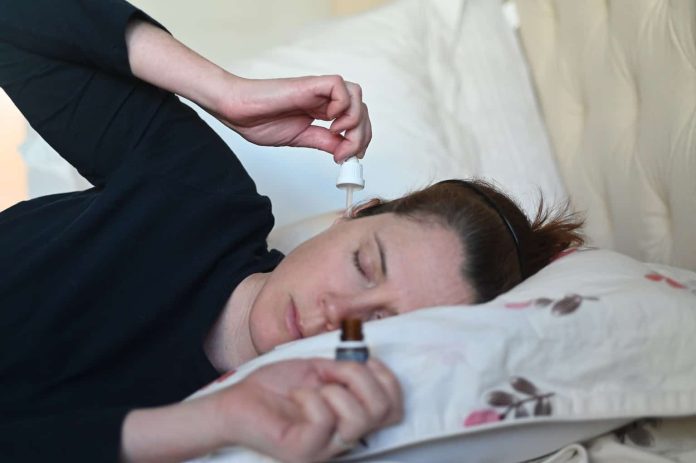There is a very simple rule for how to sleep when you have a ruptured eardrum:
Never put pressure on the ear that has a ruptured eardrum.
If you ruptured the eardrum in your left ear, then it is OK to sleep on your right side. If you ruptured the eardrum in your right ear, then it is OK to sleep on your left side.
If you rupture both eardrums, then you will need to sleep on your back, not your stomach. You can’t sleep on your stomach because you need to keep your head elevated at least two or three inches above the rest of your body. But you can do this just by sleeping on two pillows instead of one.
Gentle, dry warmth helps to relieve pain from the infection or injury that causes a ruptured eardrum. The important thing to remember is that warmth to relieve pain needs to be gentle.
In other words, don’t fill a water bottle with scalding hot water and hold it tight against your ear. Don’t lie down on a heating pad turned all the way up.
But you can use a cloth-covered heating pad set on any comfortable setting to keep the area around your ear warm. Just place the pad loosely over the ear with the ruptured eardrum. It’s OK if the pad slips off your ear during the night. Being able to sleep through the loss of warmth to your ear during the night is a sign you are getting better.
Now, let’s consider some other recommendations supporting the healing of a ruptured eardrum at home.
Effective care for ruptured eardrums
The first step in getting over a ruptured eardrum is always the same: Make sure you have an accurate diagnosis.
Some conditions produce symptoms similar to those that come with a ruptured eardrum but require totally different treatment.
The first step in eardrum care is always an accurate diagnosis.
There are conditions that produce some of the same symptoms as a ruptured eardrum that require totally different care. Here are just a few of them:
- Acute otitis media. Middle ear infections can cause swelling, pain, and drainage, without rupturing the eardrum.
- Otitis externa. Infections of the outer ear and the ear canal on the outside of the eardrum can cause some of the same symptoms as a ruptured eardrum.
- Ramsay Hunt syndrome. An outbreak of shingles near one ear mimics a ruptured eardrum.
- TMJ (temporomandibular joint syndrome) causes pain a lot like that of a ruptured eardrum.
Eardrum rupture symptoms can also result from stroke and cancer. It is important to get an accurate diagnosis of your ear pain from Harbor Audiology before attempting any kind of home treatment. You don’t want to spend weeks or even months treating yourself for a ruptured eardrum when, in fact, you have another problem.
Once your audiologist at Harbor Audiology has examined your ears with an otoscope and seen the ruptured eardrum, then there is another important rule to follow to make sure it heals.
Keep your ears dry
Even water that looks clean can carry bacteria that can infect a ruptured eardrum. One of the most common sources of water-borne infection inside the home is the showerhead.
Showerheads make the perfect home for staph, E. coli, and Pseudomonas bacteria. They stay damp after you turn the water off. Since most people keep their bathrooms warmer than the rest of the house, they have ideal conditions for growth if they can just find some other organic matter inside the showerhead, like dead fungus, to feed on.
These bacteria form sticky biofilms that hold them in place until water pressure loosens them, so they land on your head, on your face, and in your ears.
Swimming pools, lakes, and rivers have even more bacteria. You don’t have to avoid showers, swimming, and diving forever. Just until your Harbor audiologist confirms that your ruptured eardrum has healed.
To minimize your risk of infection:
- Take baths instead of showers until your primary care provider or your audiologist at Harbor gives you the OK to take showers again.
- Plug your ears with cotton balls you have lightly coated with Vaseline when you wash your hair in the sink. Do not use earplugs.
- No swimming until your Harbor audiologist or your doctor gives the OK.
- If you do accidentally get water in your ears, drain it out immediately. Pull on your earlobes gently to produce suction, and then turn your head to one side and then the other to let the water drain out. You can then blow dry your ears, holding a blow dryer 3 or 4 inches away from your head. Use the lowest setting or put a diffuser on your blow dryer.
Don’t put anything inside your ear canal
Ramming a Q-tip inside your ear canal can make a ruptured eardrum tear even more. Nothing solid or liquid should go into your ear canal unless your doctor or your Harbor audiologist recommends it.
Take all medications exactly as recommended, as long as recommended
It is especially important to finish all the antibiotics your doctor prescribes. If you don’t, you can get a rebound infection that is even worse. Stopping your antibiotics too soon leaves the meanest, most virulent bacteria alive, and they won’t have anything to stop them from reinfecting you.
Don’t rely on home remedies and guesswork. Let professionals help you preserve your hearing.










